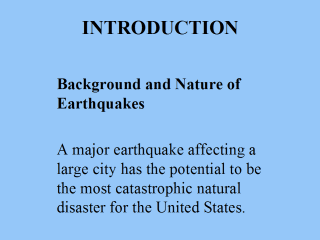| front |1 |2 |3 |4 |5 |6 |7 |8 |9 |10 |11 |12 |13 |14 |15 |16 |17 |18 |19 |20 |21 |22 |23 |24 |25 |26 |27 |28 |29 |30 |31 |32 |review |

|
Worldwide, more
than 1,000,000 earthquakes occur each year, an average of about 2 each
minute (1). Research indicates a 60% probability that an earthquake
of Richter magnitude 7.5 or greater will occur on the San Andreas fault in
southern California within the next 30 years, and a 50% probability that an
earthquake of 7.0 or greater magnitude will occur on the San Andreas or
Hayward faults in the San Francisco Bay region within the same time period
(2). In the central United States, a recent study estimates a 40% to
63% probability of a Richter magnitude 6.0 earthquake occurring in the New
Madrid seismic zone before the year 2000 (3). As previewed by the
significant damages resulting from the 1989 Loma Prieta earthquake in
northern California (magnitude 7.1) and the 1994 Northridge earthquake in
southern California (magnitude 6.8), the impact of the predicted higher
magnitude earthquakes in California and the central United States could
potentially kill and injure thousands of people, result in billions of
dollars in property loss, and cause severe disruptions to the economy (4). Despite the remarkable scientific progress in seismology and earthquake engineering during the past several years, the aim of achieving high standards of life safety against earthquakes globally has yet to be achieved. |